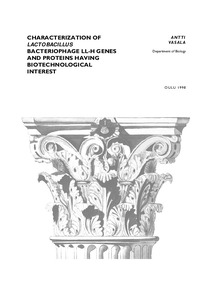Characterization of <em>Lactobacillus</em> bacteriophage LL-H genes and proteins having biotechnological interest
Vasala, Antti (1998-11-11)
Avaa tiedosto
https://urn.fi/URN:ISBN:9514250826
Kuvaus
Tiivistelmä
Abstract
Two regions of the genome of the Lactobacillus delbrueckii subsp. lactis bacteriophage LL-H were characterized, representing 14% of the phage genome. The first region of 2497 bp contained genes encoding phage structural proteins and the second region of 2498 bp genes involved in lytic functions. The nucleotide sequences of the major capsid protein gene g34, a putative capsid morphogenesis gene (ORF178A), the gene mur encoding phage cell wall hydrolase (lysin), the gene hol (ORF107) encoding the cell membrane permeabilizing phage holin, and six other genes with unknown function were found. Identification of these genes was performed by amino acid sequencing of their encoded proteins (genes g34 and mur), by their physiological effect on E. coli (genes hol and mur), by sequence comparison (genes mur, hol, ORF178A), and by biochemical analysis of their encoded purified protein (gene mur). A promoter for the capsid protein encoding gene cluster was determined by primer extension method. A purification method suitable for large scale processing (cation exchange chromatography by expanded bed adsorption method) was developed for the phage LL-H lysin protein Mur. Purified Mur was biochemically determined as a N-acetylmuramidase, which was effective on cell walls of Lb. delbrueckii, Lb. helveticus, Lb. acidophilus and Pediococcus damnosus. Some biotechnological applications for the lysis genes hol and mur or the purified protein Mur are suggested. Mur digests E. coli cell walls inefficiently, but could still be used for lysis of E. coli. Coexpression of the phage LL-H lysin and holin genes yielded to lysis of the E. coli host only at low culture densities. Therefore, some chemicals were tested for their ability to trigger lysis of E. coli cells over expressing the phage LL-H gene mur. Thymol was found to mimic the physiological effects of the phage holin in a bacterial growth state independent manner. An efficient lysis method utilizing intracellular production of Mur and triggering the lysis with thymol was developed.
Kokoelmat
- Avoin saatavuus [32523]
